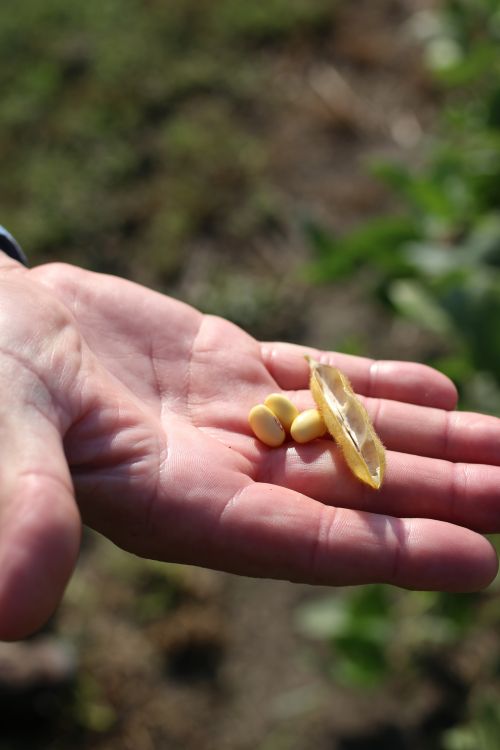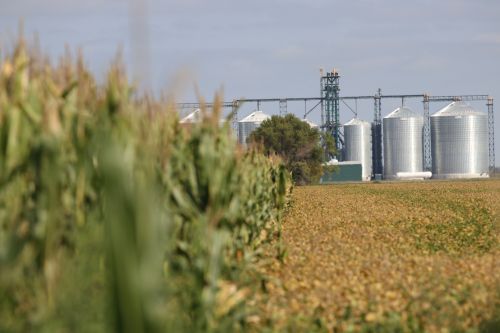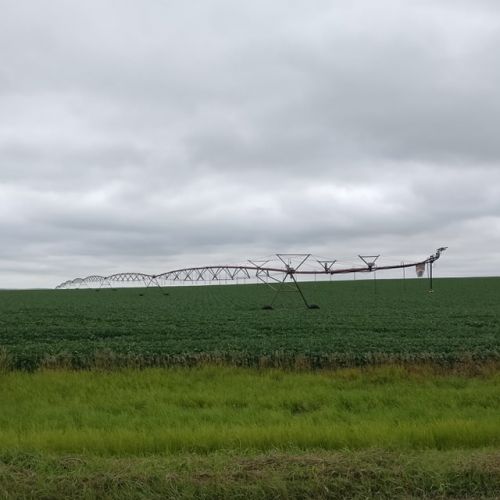News | August 14th, 2019

FARGO – Farmers don’t talk politics at the elevator, it’s almost an unwritten rule. But when the trade war with China broke out, conversations changed.
“Now every time I go to the elevator it’s fricking Trump this and fricking Trump that,” Todd Leake, a farmer, said. “When they’re listening to the markets they’re smashing their hands on the dashboard of their pickups saying they’re pissed off at Trump.”
Why President Donald Trump’s overall approval rating has dropped approximately 18 percentage points in North Dakota, according to the latest Morning Consult and other polls, is anyone’s guess, but America’s escalating trade war with China has dealt one body blow after another against American farmers, putting North Dakota’s entire agricultural industry in jeopardy.
Although trade between the two countries has been unequal for decades, mastermind behind the current trade war, Trump, began beating his war drum as early as September 21, 2011 when he tweeted: “China is neither an ally or a friend – they want to beat us and own our country.” Trump later campaigned on the same premise, and fired the first shot on February 7, 2018, when the US implemented ‘global safeguard tariffs’ or a 30 percent tariff on all solar panels and washing machine parts.
Since then, the United States levied $250 billion worth of tariffs exclusively to Chinese goods, and the Chinese fired back, applying $110 billion in tariffs to US goods. Claiming China is a money manipulator, another round of tariffs are expected to strike on September 1 on $300 billion worth of Chinese goods. In retaliation, China has suspended purchases of all US agricultural products, news that hit North Dakota – the nation’s ninth largest agricultural exporter – hard, and in the pocketbook.
“When this happened there was a definite disregard for Mr. Trump’s policies, put it that way,” Leake, also the former president for the Grand Forks County Farmers Union, said. “That’s what I hear. And if they are honest they would say the same thing. They’ll go find some lackeys who will say ‘Oh, I’m all for Trump.’ But really, people are not for Trump when it comes to what he’s doing to their income. That’s where the rubber meets the road for most people.”
Don’t believe propaganda that North Dakota farmers are being “good patriots” and vow to struggle through the trade war – Trump support intact, Leake said. Farmers, according to U.S. Agricultural Secretary George “Sonny” Perdue have been demoted to “whiners.”
“There are some people who want to get on to the media, or there are certain people who are members of various commodity organizations, or farm bureaus and they’ll get their token people out there that will sit there and talk up Trump and say this is the best thing,” Leake said.
“How can it be the best thing when you had unlimited access to the biggest soybean market in the world and then it’s been cut off completely?”
Senator Jim Dotzenrod, who ran for the agricultural commissioner in 2018, is also a soybean farmer in Wyndmere. Bluster before the trade war was expected, but once tariffs were put into the equation, Trump crossed the line, he said.
“The reason I felt motivated to run for ag commissioner was because of this trade war,” Dotzenrod said. “Where we are now seems to be quite predictable. There’s a shock in the markets right now, but we’re destined for a world full of cheap grain.”
Grain is wheat, corn, and soybeans.
“This whole thing puzzles me,” Dotzenrod said. “Trump said if I am elected President we are going to get out of all these trade agreements and I am going to impose tariffs. I heard that and I thought farmers are not going to vote for this guy. This will take a wrecking ball to the ag industry, and then farmers turned around and voted for him.”
When he asks farmers why, their response was: “‘He’s a businessman, he knows how to make a deal, he will get nations to the table.’
“Everyone thought he knew ‘The Art of the Deal,’ but he’s a deal breaker,” Dotzenrod said.
“The sense I’ve gotten is that I am hearing a little less of the aggressive comeback, there seems to be a more quiet, sheepish response. There was a lot of swagger there, but today when I bring this up, I don’t think anyone wants to admit we voted for the wrong guy. It has changed.”

Refugee soybeans
The continuing trade war created uncountable “refugee soybeans” without a home. Leake just finished selling last year’s crop at a $3.8 per bushel loss to make room for soybeans he planted this year. He will be looking at alternative crops for next year, he said. At $7.2 per bushel, soybeans should be sold for higher.
“That $11 bucks represents to a farmer the ability to break even and make a living,” Leake said.
Late last month, China’s General Administration of Customs announced that Beijing has turned to Russia for soybeans, a crop that hit sales records primarily from trade to China in North Dakota of $2.13 billion in 2017.
Decades of negotiations and deals – especially related to North Dakota soybeans to China, the world’s largest importer – are now broken, and in peril of disappearing into Russian, Ukrainian, or Brazilian pockets forever.
“The main thing is the ag service and the soybean councils have spent decades building these trade relationships,” Leake said. “We are not responsible for the flight of manufacturing over to China. The one thing that is keeping some sort of semblance of a trade balance with China was our agricultural experts.
“The Trump Administration has basically sold us down the river, I don’t know if everyone even knows what that means anymore,” Leake said.
North Dakota’s “refugee soybeans” are dried, stockpiled, and wait for buyers, but the beans that once fattened Chinese cattle and hogs won’t last forever, Harrison Weber, director of market development for the North Dakota Soybean Council, said.
“Combine them cold and put into storage at cooler temps they hold their quality,” Weber said. “Will they store forever? No, definitely not.”
Before the trade war began farmers in North Dakota planted 7 million acres. Today, acreage has decreased to 2015 levels, around 5.7 million acres, Weber said. Those that had no pre-arranged trade deals last year – about 20 percent – are storing the beans in silos, and for the most part still own the beans as there is no federal or state buyout program, Weber said. Markets are switching gears to China’s southern neighbors.
“I can tell you from the check off side, 100 percent farmer dollars, they’ve been investing in foreign countries, particularly in Southeast Asia, and we are starting to see quite a bit of success in the Pacific Northwest,” Weber said. The Pacific Northwest is where North Dakota’s agricultural products headed toward China are loaded onto ships.
“China is obviously the big dog there, but we are seeing success in exports to other Southeast Asian countries,” Weber said. “Is there hope for North Dakota farmers and the Chinese market? Last week there were still vessels leaving and going to China, but they’re definitely down.”
Opening new markets in other countries such as Southeast Asia won’t make up the loss of China’s agricultural markets, Leake said.
“We’re already exporting to Pacific Rim countries, Leake said. “And sure, that’s always good to grow, but you can’t make up an excuse to lose your largest exporting market and make excuses for Trump.”

As farmers begin applying for a second round of handouts – $7 billion slated for this summer – payments are based on damage criteria to provide aid to farmers hurt by “unjustified retaliatory tariffs” from the Trump Administration’s trade war with China, from $15 to $150 an acre, with a limit of $500,000 per person, according to Bloomberg.
As chairman of the Senate Agriculture Appropriations Committee, North Dakota Senator John Hoeven, a Republican, helped procure another $16 billion in Market Facilitation Program, or MFP payments, saying that farmers will receive the greater of either 50 percent or a $15 per acre minimum in initial payments. The USDA is also implementing a farm purchase portion of the agriculture assistance plan that will purchase surplus commodities for food pantries, school nutrition programs, and other organizations, according to Hoeven.
North Dakota Senator Kevin Cramer, a Republican, has backed Trump on issues including the trade war 100 percent of the time, just as Cramer promised during his campaign race. While saying North Dakota farmers have a low pain threshold, he supports Trump using the “strongest weapons in his arsenal” in the trade war with China.
Last year, U.S. farm income dropped 16 percent to $63 billion, and is expected to tick upwards 10 percent to $69.4 billion this year, according to the U.S. Department of Agriculture. The slight jump pales in comparison to farm income from 2013 of $136.1 billion, and still well below the national average of $90 billion per year.
Although the Department of Agriculture predicts a little growth this year, Goldman Sachs economists say not so fast, and fear the trade war will lead into another recession.
U.S. agricultural exports to China also dropped after the trade war began, falling from $19.5 billion in 2017 to $9.2 billion in 2018, according to Bloomberg.
“I think Donald Trump will do more damage to agriculture than any President in history,” Jim Dotzenrod said. “I don’t know how we will fix this. Once you lose your reputation, which you can lose in a few minutes, it’s over, and we’re sending this message to the rest of the world that you need to find other suppliers, and that’s a terrible message.”

North Dakota: a farmer’s welfare state
“Every little bit helps,” Todd Leake, who is also a member of the Dakota Resource Council, said about the subsidies he receives for his 1,800-acre farm.
This year, Leake planted half soybeans half wheat, he said. Not knowing where he can make money on his crops, the current trade war is on a path to destroy what the Homestead Act of 1862 created: family farms like his.
Crop insurance subsidies are working quietly against him, and others with small farms.
“The Trump Administration was actually on the right course with that trying to limit to $40,000 per legal entity, which was still pretty high, but the consequence is that large corporate farms and large limited liability partnerships are able to tap into an unlimited amount of crop insurance subsidies so that their risk management is basically taken care of,” Leake said. “They can get as much crop insurance as they want, they can expand as much as they want to the detriment of the land and family farmers.”
Policies need to gear the agricultural community toward the family farmer, and “not set the whole thing up to have family farmers take the fall and then have large corporations and large limited liability partnerships come in and take over the land base,” Leake said.
Every year the federal government spends more than $20 billion in handouts – privately administered and publicly subsidized – to more than two million farmers in the United States, according to the Cato Institute, a public policy think tank.
From all 50 states, North Dakota farmers receive the highest percentage of federal subsidies, more than doubling the national average, according to the Environmental Working Group, a nonprofit focusing on corporate accountability. North Dakota currently has approximately 26,364 farms, of which 20,511 or approximately 77.8 percent receive subsidies from the federal government.
In comparison 14.4 percent of Texas farmers, 26.3 percent of Oklahoma farmers, 38.9 percent of Montana farmers, and 72.1 percent of South Dakota farmers receive federal subsidies.
Approximately 77,719 farmers in North Dakota have received federal handouts since 1995, according to the EWG, which obtained its data from the U.S. Department of Agriculture with a Freedom of Information Act request.

The US Department of Agriculture Foreign Agricultural Service reported that $300 million of Agricultural Trade Promotion Program or ATP monies have been disseminated. They do not categorize the handouts by state. Of that amount, $34,632,165 in ATP funding has been given to the American Soybean Association, of which the North Dakota Soybean Growers Association is affiliated with.
Included in the EWG information are recipients by name. How much of the current trade war’s monies are not specified, but annual totals are included.
The top five recipients of federal bailouts include:
Johnson Farms, a well-known farming cooperative that owns more than 20,000 acres out of Walhalla received $10,536,684 from 1995 until 2018 primarily for wheat subsidies, but only received $19,453 in listed subsidies in 2018.
Ktm Farm, a family-owned farm near Wahpeton, received $6,637,413 from 1995 until 2018 from mostly wheat, soybean, and corn subsidies with one of the largest federal handouts of $632,236 in 2018.
Kohler Farms Partnership in Valley City received $6,559,967 from 1995 until 2018, with a massive subsidy jump last year to $567,974 primarily for wheat, soybean, and corn subsidies.
Dalrymple Farms, once the largest of all bonanza farms with more than 70,000 acres, was created by former Governor Jack Dalrymple’s great-grandfather Oliver Dalrymple in 1875. The farm was later split into parcels then sold, but Jack Dalrymple continues to manage what is left and has received $5,805,900 in federal subsidies since 1995, with $247,536 for wheat and soybean subsidies in 2018. Last year’s handout was not the highest: in 2000, Dalrymple Farms received $934,612 and in 2001 received 945,967 in commodity subsidies.
Weckerly Farms Partnership, a family farm near Hurdsfield received $5,397,200 primarily from wheat, corn, soybean, and barley subsidies with the largest subsidy of $705,401 in 2018. Chad Weckerly is director of the North Dakota Farm Bureau according to the North Dakota Farm Bureau website.
The next 15 farms on the first page of the EWG listings received between $4.4 million to $3 million since 1995 in government handouts.
Craig Thorfinnson, a Pembina County farmer, votes liberal, and also receives subsidies for his small farm, which help, but the current system isn’t set up to help the family farm, he said.
“I sit in the café here, I am one liberal out of ten conservatives,” Thorfinnson said. “When they talk about these MFP payments I say, ‘You aren’t taking that are you? That’s socialism. You guys can’t take that.’”
In contrast, Jim Dotzenrod has received a total of $82,821 since 1999 with $8,792 in federal subsidies in 2018, primarily for corn and soybean crops, according to EWG. Typically, Dotzenrod receives $1,275 per year, but in 2013 he received his highest payment of $13,728.

Funny money
When Craig Thorfinnson reads the market reports, his heart sinks. Corn market dropped 25 percent, wheat down 12 cents, the trade war intensifies, and he knows the agricultural industry in North Dakota is on the cusp of change.
The trade war is setting up the family farmer for disaster once again, he said. He’s thinking of growing hemp.
“You can’t fix this right now; we don’t have any place to sell anything,” Thorfinnson said. “It isn’t going to be stopped, it’s already done the damage.”
An agreement with Mexico would help farmers in North Dakota, but “big pharma” is interfering, buying out competition and saying no more generic medicines, which will hurt the agricultural sector. The trade war is making room for big business to move in.
“The markets are gone, and the rest of the world is going to squeeze us every chance they get,” Thorfinnson said. “Agriculture in the United States is going to have to change.”
At 66 years old, Thorfinnson remembers his father, a lifelong Republican’s advice: “Beware of the industrial complex.”
“It won’t be done by government owned property, it will be done by the rich working with the government, a sort of fascist type,” Thorfinnson said.
Large corporate farms may be able to weather a prolonged trade war, but farms like Todd Leake’s and Thorfinnson’s can’t survive without great change. Leake has to navigate trade relations, politics, the stock market, and the weather to find a replacement crop. Soybeans don’t require fertilizers and are relatively low maintenance to grow, so he’s not sure yet what the future will bring no matter how the trade war ends.
“In the interim, all we can do is take the funny money and try and switch crops and cover our expenses,” Leake said.
Walk into the USDA office in Fargo and like all government offices there is a picture of the President, but here there is also an official picture of the “Sonny” Perdue standing in a soybean field.
“Stick up for the American farmer,” Leake said. “I can’t think of anything more ludicrous if he doesn’t strap on a pair and take Trump on and refuse to resign. That’s what the situation calls for. That and the soybean councils and the growers associations, tearing Mr. Trump a new one.”
If healthy negotiations could begin, China might be persuaded that efficient, long term, reliable suppliers are ready to do business in the Midwest, Leake said.
“We can’t have a drought or a weather adverse situation where we won’t have a large supply,” Leake said. “That would be the most advantageous.”
North Dakota soybeans may be gone forever as other markets won’t make up for the loss of the largest importer in the world, Jim Dotzenrod said.
“For us up here, the big thing that has a big success story, was our ability in the north to raise soybeans,” Dotzenrod said. “We had an advantage over the farmers in the southern Corn Belt. This was almost specifically tailored to give a great advantage to North Dakota.
“The loss of the soybean market has damaged North Dakota as much as any state in the country.
“I don’t know that I can say that it can’t be fixed, but how do you rebuild trust? Is it possible that we could have a future, a change of attitude in our country’s trade policies that would try to be more accommodative to our consumers around the world? We can’t be sticking our fingers in the eyes of our allies.”
Fighting a trade war from Twitter and not listening to advisors is not what Trump should be doing, Leake said.
“The immaturity of Mr. Trump, he doesn’t understand international trade, he’s a real estate developer and he’s not listening to his advisors, doing this stuff by fiat, I think the man should hopefully lose the next election,” Leake said. “If he’s going to conduct all of his business that way, and goes with the easiest least desirable methodologies then I think the U.S. has got to get control of its political system so that this doesn’t happen ever again.”
July 15th 2025
July 7th 2025
June 9th 2025
April 30th 2025
April 24th 2025
__293px-wide.jpg)




